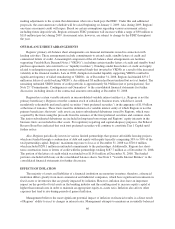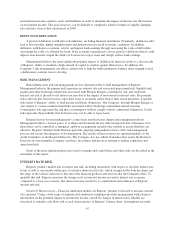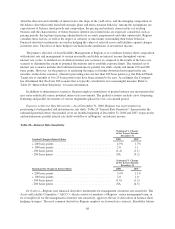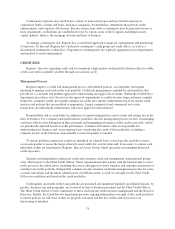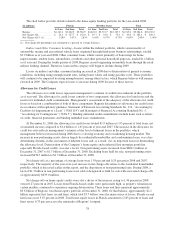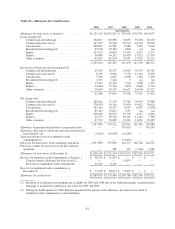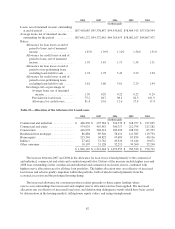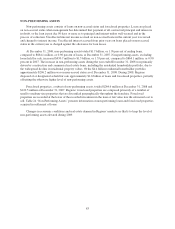Regions Bank 2008 Annual Report Download - page 83
Download and view the complete annual report
Please find page 83 of the 2008 Regions Bank annual report below. You can navigate through the pages in the report by either clicking on the pages listed below, or by using the keyword search tool below to find specific information within the annual report.risk associated with these contracts is typically limited to the cost of replacing all contracts on which Morgan
Keegan has recorded an unrealized gain. For exchange-traded contracts, the clearing organization acts as the
counterparty to specific transactions and, therefore, bears the risk of delivery to and from counterparties.
Interest rate risk at Morgan Keegan arises from the exposure of holding interest-sensitive financial
instruments such as government, corporate and municipal bonds, and certain preferred equities. Morgan Keegan
manages its exposure to interest rate risk by setting and monitoring limits and, where feasible, entering into
offsetting positions in securities with similar interest rate risk characteristics. Securities inventories, recorded in
trading account assets on the consolidated balance sheets, are marked-to-market and, accordingly, there are no
unrecorded gains or losses in value. While a significant portion of the securities inventories have contractual
maturities in excess of five years, these inventories, on average, turn over in excess of twelve times per year.
Accordingly, the exposure to interest rate risk inherent in Morgan Keegan’s securities inventories is less than that
of similar financial instruments held by firms in other industries. Morgan Keegan’s equity securities inventories
are exposed to risk of loss in the event of unfavorable price movements. Also, Morgan Keegan is subject to credit
risk arising from non-performance by trading counterparties, customers and issuers of debt securities owned.
This risk is managed by imposing and monitoring position limits, monitoring trading counterparties, reviewing
security concentrations, holding and marking to market collateral, and conducting business through clearing
organizations that guarantee performance. Morgan Keegan regularly participates in the trading of some
derivative securities for its customers; however, this activity does not involve Morgan Keegan acquiring a
position or commitment in these products and this trading is not a significant portion of Morgan Keegan’s
business.
To manage trading risks arising from interest rate and equity price risks, Regions uses a Value at Risk
(“VAR”) model to measure the potential fair value the Company could lose on its trading positions given a
specified statistical confidence level and time-to-liquidate time horizon. The end-of-period VAR was
approximately $1.1 million as of December 31, 2008 and approximately $1.8 million as of December 31, 2007.
Maximum daily VAR utilization during 2008 was $3.6 million and average daily VAR during the same period
was $1.7 million.
Morgan Keegan has been an underwriter and dealer in auction rate securities. Morgan Keegan has been
contacted by securities regulators and is working on a plan to provide liquidity to customers holding these
instruments. Other broker dealers have entered into settlements with regulators under which the broker dealers
agreed to repurchase certain of the securities at par. As of December 31, 2008, approximately $462.1 million of
auction rate securities were subject to repurchase, and Morgan Keegan held approximately $139.8 million of
auction rate securities on the balance sheet. During 2008, Morgan Keegan recorded valuation adjustments related
to those auction rate securities. Such valuation adjustments were not significant.
On June 4, 2007, the Illinois Secretary of State, Securities Department (“ISD”) issued a Notice of Hearing
alleging that Morgan Keegan failed to properly disclose limitations on transferability of shares of certain mutual
funds advised by an affiliate of Morgan Keegan. On January 22, 2009, Morgan Keegan and the ISD entered into
a settlement agreement requiring that Morgan Keegan (1) make a payment of fifty thousand dollars to an investor
education fund; (2) reimburse investigation costs of thirty thousand dollars; (3) waive and/or refund contingent
deferred sales charges to certain investors; (4) implement certain disclosures, training and compliance measures;
and (5) report to ISD certain investor complaints for a period of one year. On January 23, 2009 the ISD dismissed
the Notice with prejudice.
COUNTERPARTY RISK
Regions manages and monitors its exposure to other financial institutions, also known as counterparty
exposure, on an ongoing basis. The objective is to ensure that Regions appropriately identifies and reacts to risks
associated with counterparties in a timely manner. This exposure may be direct or indirect exposure that could
create legal, reputational or financial risk to the Company.
73





